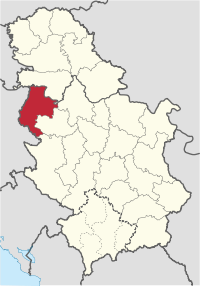Mačva District
Mačvanski okrug Мачвански округ | |
|---|---|
 Location of Mačva District in Serbia | |
| Country | |
| Capital | Šabac |
| Government | |
| • Commissioner | n/a |
| Area | |
| • Total | 3,268 km2 (1,262 sq mi) |
| Population (2011 census) | |
| • Total | 297,778 |
| • Density | 91.1/km2 (236/sq mi) |
| Municipalities | 6 and 2 cities |
| Settlements | 228 |
| - Cities and towns | 5 |
| - Villages | 223 |
Mačva District (Serbian: Мачвански округ, Mačvanski okrug, pronounced [mǎtʃʋanskiː ôkruːɡ]) is a district (okrug) of Serbia. The District expands in the western parts of Serbia, in the geographical regions of Mačva, Podrinje, Posavina, and Pocerina. It has a population of 297,778 people. The seat of the district is in the city of Šabac.
Municipalities
It encompasses the municipalities of:
Inhabited places
This article needs to be updated. (November 2011) |
Largest inhabited places in the district are (with population figures):
- Šabac (55,163)
- Loznica (19,863)
- Lozničko Polje (7,922)
- Bogatić (7,350)
- Klupci (7,297)
- Majur (6,854)
- Banja Koviljača (6,340)
- Pocerski Pričinović (5,992)
- Badovinci (5,406)
- Krupanj (4,912)
- Mali Zvornik (4,736)
- Lešnica (4,731)
- Koceljeva (4,645)
- Prnjavor (4,464)
- Ljubovija (4,130)
Ethnic groups (2002 census)
This article needs to be updated. (November 2011) |
- Serbs = 317,658 (96.37%)
- Roma = 3,235 (0.98%)
- Muslims by nationality = 1,859 (0.56%)
- others.
History and culture
Famous monuments can be seen in the vicinity of Šabac, dedicated to events from the history of Serbian people: the Monument to Karađorđe and Serbian Heroes of the First Serbian Uprising and the Museum of the Battle of Mišar, the remnants of the ancient cities on the banks of the Sava river: Novo Selo, the site of the King Milutin's Palace and Kosanin grad, the medieval fortress on the Cer Mountain.
Not far away from Loznica stands the village of Tršić, the birth place of the reformer of Serbian language and orthography, Vuk Karadžić. From Tršić, a footpath leads to the Tronoša Monastery, one of the oldest medieval endowments of the Nemanjić dynasty. This fourteenth century monastery played an important part in the preservation of Serbian culture and tradition. Over a long period, particularly during the fourteenth century, a copying school tradition was nourished in it for its own and other monasteries' needs. This preserved the historic and cultural documents of the Serbian people.
Economy
The economy of this region is characterised by the big factories of the "Zorka" chemical industry, the "Šapčanka" Food Industry, the "Jela" furniture industry and the "Metaloplastika" metal and plastics industry. One of the biggest exporters from this city is tin mill which is now owned by U.S. Steel Serbia, this mill produces more than 200.000 tones of tin plate every year.
See also
Note: All official material made by Government of Serbia is public by law. Information was taken from official website.
